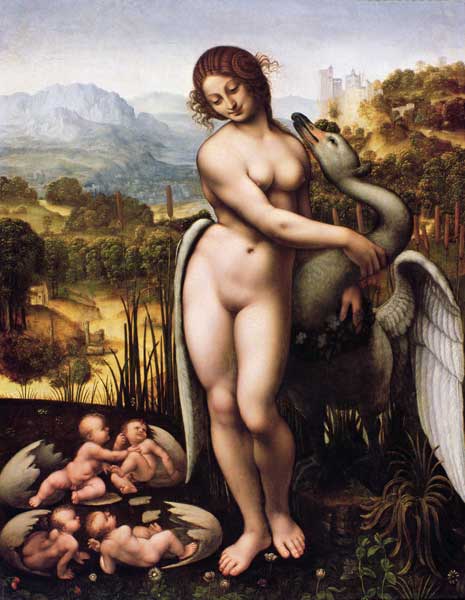Great Works: Leda And The Swan (circa 1515) after Leonardo
Wilton House, Salisbury

The High Renaissance once embodied the supreme standard, the paragon of beauty and nobility, the norm of all norms. Now it looks more like a freak show. There's Michelangelo with his muscle-bound super-heroes. There's Leonardo with his spooky-faced aliens. It's strangely fashioned world, and that's why it still appeals to our age, which delights in strangeness.
Classical myth provides it with suitably strange activities. These foundational stories of Western civilisation are as bizarre as any. When Jupiter impregnates some desirable mortal, he takes various shapes for the purpose, sometimes mineral, a cloud, a shower of gold, or sometimes animal, a bull, a swan, an eagle, a pigeon, an ant. Not all of these couplings are that easily pictured. Eurymedusa and the Ant is the subject of very few paintings. There are limits.
Leda and the Swan, on the other hand, is a common subject. And the sexual intercourse of bird and woman is often depicted very frankly. The swan is rather a small partner, but this scene it's as near as the old masters get to showing human-human sex. Avian bestiality was a more acceptable sight than the beast with two backs.
But not 100 per cent acceptable. Both Michelangelo and Leonardo treated the subject, and both of their paintings are lost now, presumed destroyed by prudish owners. They survive only through copies. Michelangelo's version shows intercourse on a couch. Leda has a pose rather similar to his sculpture of Night on the Medici Tombs. She droops half-conscious.
Leonardo, in this copy by Cesare da Sesto, takes the subject in quite another direction. In his Leda and the Swan he finds possibilities stranger than mere sex. His picture imagines the story beyond the one-off act of impregnation. It forgets that this swan is even meant to be Jupiter in temporary disguise. He portrays the connubial bliss of woman and bird.
Here we have the couple living together, swan and wife, next to hubby's home pond – note all the bulrushes rising among the closely observed vegetation. We see them standing side-by-side, a pair enjoying an ongoing love-life, both naked, snuggling, canoodling, and necking.
The swan puts a fond and protecting wing around Leda. Its rim closely hugs the long curve of her hip and thigh, as a human male lover might grasp his woman's shoulder. In Leonardo's time, did they have that old saw about the blow of a swan's wing being powerful enough to break an arm? Was it natural then to see swans as strong as well as graceful?
The swan's neck, meanwhile, is garlanded at it base, and then goes into a writhing undulation like a charmed snake. Her hands embrace and stroke it. Its beak comes up for a peck. We see it on the point of nuzzling her shoulder. There's the most indecent suggestion of masturbation, or perhaps of a prehensile penis. Leda, with her Mona Lisa smirk, looks away coyly, demurely.
There's a touch of realism. Most Leda paintings, even when in flagrante delicto, show only the swan's neck and wings. They stress, that it, the graceful, feathery, visible-above-water aspect of the bird. But Leonardo gives the awkward physical facts. His double standing portrait includes the swan's bottom half, its gross legs with their paddle feet, standing squarely and squatly, and standing on some mound, to make up for the way the creature is so much shorter than its spouse. And then there's the strangest aspect of this relationship: its offspring. Intercourse between swan and woman can be just about envisaged. Humans and birds both breed that way. But humans do not give birth by laying eggs. They do not arrive in the world by breaking out of a shell, already well formed and active.
That seems to be the moment in the story that Leonardo illustrates: the hatching. The sitting, the nesting, the really odd aspects of life, if humans were oviparous, he leaves to our imagination. But he shows enough of the thing, and it's like something out of Hieronymus Bosch.
Not one egg but two, and in each egg twins, four babies tumbling out of their broken containers and wriggling into life. (The legend involves even weirder biology: two of these quads were Jupiter's, two were engendered by a human king.)
But what you would never get in Bosch is Leda's body itself. It stands as the picture's central upright. Its firm but gentle curvature is there to calm down – or to show up – the bizarreries on either side of it. Here at least is normality. She seems to be about to step out of the scene.
Join our commenting forum
Join thought-provoking conversations, follow other Independent readers and see their replies
Comments